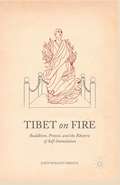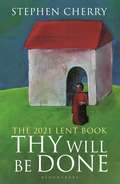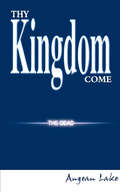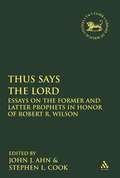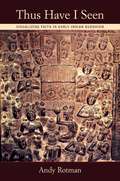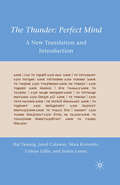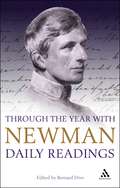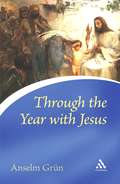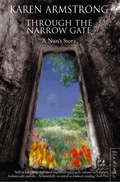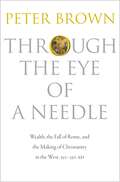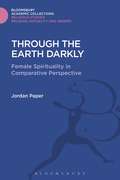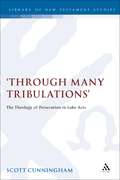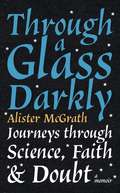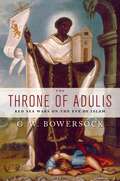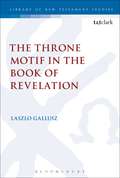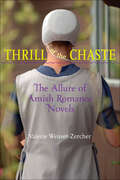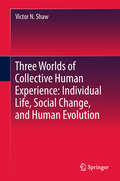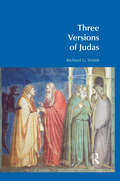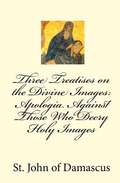- Table View
- List View
Tibet on Fire: Buddhism, Protest, and the Rhetoric of Self-Immolation
by John Whalen-BridgeUsing Kenneth Burke's concept of dramatism as a way of exploring multiple motivations in symbolic expression, Tibet on Fire examines the Tibetan self-immolation movement of 2011-2015. The volume asserts that the self-immolation act is an affirmation of Tibetan identity in the face of cultural genocide.
Thy Will Be Done: The 2021 Lent Book
by Stephen CherryAt a time of change, uncertainty and widespread anxiety, we need to discover again the freshness of our most familiar spiritual resources. Stephen Cherry's Lent Book does exactly this by inviting the reader to immerse themselves in the most central, important and iconic of Christian prayers – the Lord's Prayer, the Our Father.Mining the tradition for wisdom and insight, and finding inspiration in the theologians of the past such as St Paul, Gregory of Nyssa, John Calvin, but also more contemporary voices such as Evelyn Underhill, Simone Weil, and Michelle Obama, Thy Will Be Done presents the comforts and challenges of the prayer in 36 short chapters. This most accessible Lent Book, rich in anecdote as well as analysis, is daily bread for the spiritually hungry.
Thy Will Be Done: The 2021 Lent Book
by Stephen CherryAt a time of change, uncertainty and widespread anxiety, we need to discover again the freshness of our most familiar spiritual resources. Stephen Cherry's Lent Book does exactly this by inviting the reader to immerse themselves in the most central, important and iconic of Christian prayers – the Lord's Prayer, the Our Father.Mining the tradition for wisdom and insight, and finding inspiration in the theologians of the past such as St Paul, Gregory of Nyssa, John Calvin, but also more contemporary voices such as Evelyn Underhill, Simone Weil, and Michelle Obama, Thy Will Be Done presents the comforts and challenges of the prayer in 36 short chapters. This most accessible Lent Book, rich in anecdote as well as analysis, is daily bread for the spiritually hungry.
Thy Kingdom Come
by Augean LakeA dark comedy that takes place in the overwhelming afterlife of sin, sultry luxury, simmering lava pools and more. Walk with the Holy and the Unholy, the Blessed and the Unblessed, the Forgiven and the Unforgiven, in three kingdoms filled with love, lust and sin. Follow the tough guy, Cleavage, the mindless, unscrupulous womanizer, Grengo, and the lethal human weapon, Wohl, after they go skidding off a cliff's edge on their Harley-Davidson's. They cause havoc among the jeweled Angels of Heaven and the sexy, voluptuous Angels of Hell alike. 'Thy Kingdom Come' is a witness to the fight against the malicious and vengeful Lucifer and his wicked comrades in sin. Who will triumph?
Thus Says the LORD: Essays on the Former and Latter Prophets in Honor of Robert R. Wilson (The Library of Hebrew Bible/Old Testament Studies)
by Stephen L. Cook John J. AhnThis work assembles contributions from North America's leading Hebrew Bible/Old Testament scholars in honor of a highly respected biblical scholar, whose work on biblical prophets has been especially influential. Within the list are former teachers, current colleagues, and former students who are now colleagues in their own right, representing a wide range of denominational traditions represented-Roman Catholics, Lutheran, Episcopal, Presbyterian, etc. The book is divided into major two sections with a brief introduction by the editors, John Ahn and the Stephen Cook. Here, a brief biography and the academic career of Robert Wilson's contribution to the guild (with a bibliography at the end of this section) and more over, at a personal level, his ceaseless work in helping to transform and reform the "new" Yale Divinity School and his impact in molding the Ph.D. program in HB/OT in the Religious Studies Department of the Graduate School at Yale University. Part I hold the essays on the Former Prophets and Part II on the Latter Prophets.
Thus Have I Seen: Visualizing Faith in Early Indian Buddhism
by Andy RotmanAlthough Buddhism is often depicted as a religion of meditators and philosophers, some of the earliest writings extant in India offer a very different portrait of the Buddhist practitioner. In Indian Buddhist narratives from the early centuries of the Common Era, most lay religious practice consists not of reading, praying, or meditating, but of visually engaging with certain kinds of objects. These visual practices, moreover, are represented as the primary means of cultivating faith, a necessary precondition for proceeding along the Buddhist spiritual path. In Thus Have I Seen: Visualizing Faith in Early Indian Buddhism, Andy Rotman examines these visual practices and how they function as a kind of skeleton key for opening up Buddhist conceptualizations about the world and the ways it should be navigated. Rotman's analysis is based primarily on stories from the Divyavadana (Divine Stories), one of the most important collections of ancient Buddhist narratives from India. Though discourses of the Buddha are well known for their opening words, "thus have I heard" - for Buddhist teachings were first preserved and transmitted orally - the Divyavadana presents a very different model for disseminating the Buddhist dharma. Devotees are enjoined to look, not just hear, and visual legacies and lineages are shown to trump their oral counterparts. As Rotman makes clear, this configuration of the visual fundamentally transforms the world of the Buddhist practitioner, changing what one sees, what one believes, and what one does.
The Thunder: A New Translation and Introduction
by H. Taussig J. Calaway M. Kotrosits C. Lillie J. LasserThis is the first book-length treatment in English of the Nag Hammadi text, The Thunder: Perfect Mind - a poem of 'I am' statements that has garnered a strong following in mainstream culture. This book offers a fresh, current translation (with detailed Coptic annotations) and ten chapters of introductory analysis of the text.
Through the Year with Newman: Daily Readings
by Bernard DiveJohn Henry Newman was a great thinker - a seminal theologian and philosopher - but he possessed something more than intellectual brilliance: he possessed wisdom and a profound devotional life. He brought to any practical topic an awareness of the unity and consistency of the Christian faith. His writings are shot through with insights that get to the very core of what Christianity means.Who better to take as a spiritual guide? Through the Year with Newman is a collection of reflections and prayers - one for every day of the year. It focuses on core Christian doctrines as presented with piercing clarity by Newman. It concentrates less on controversial issues than on matters of faith common to all Christians; but it also gets across the essence of the distinctive achievement of Newman, a sense of his central ideas and of the complexion of his thought.
Through the Year with Newman: Daily Readings
by Bernard DiveJohn Henry Newman was a great thinker - a seminal theologian and philosopher - but he possessed something more than intellectual brilliance: he possessed wisdom and a profound devotional life. He brought to any practical topic an awareness of the unity and consistency of the Christian faith. His writings are shot through with insights that get to the very core of what Christianity means.Who better to take as a spiritual guide? Through the Year with Newman is a collection of reflections and prayers - one for every day of the year. It focuses on core Christian doctrines as presented with piercing clarity by Newman. It concentrates less on controversial issues than on matters of faith common to all Christians; but it also gets across the essence of the distinctive achievement of Newman, a sense of his central ideas and of the complexion of his thought.
Through the Year with Jesus (Continuum Icons)
by Anselm GrünHere is an entirely fresh and original book about Jesus, the Jesus of devotion, the Jesus within.Here are fifty pictures (or images) of Jesus, each being a chapter of the book. We need to get away from cliches and see what Jesus really means for people today. After a brief account of Jesus and his times, the author introduces the book and how to read it. Some of the pictures of Jesus are surprising- Jesus the drop out, the vagabond, the one who refuses power,the family therapist and the exorcist.Gruen has a rare gift of simple communication, of bringing Jesus alive to modern men and women.This was a gift which Henri Nouwen also had and the publishers are expecting to command similar sales.The style is simple and direct and psychologically in tune with our times.
Through the Narrow Gate: A Nun's Story
by Karen ArmstrongThrough the Narrow Gate is Karen Armstrong’s memoir of life inside a Catholic convent in the 1960’s.
Through the Eye of a Needle: Wealth, the Fall of Rome, and the Making of Christianity in the West, 350-550 AD
by Peter BrownJesus taught his followers that it is easier for a camel to go through the eye of a needle than for a rich man to enter heaven. Yet by the fall of Rome, the church was becoming rich beyond measure. Through the Eye of a Needle is a sweeping intellectual and social history of the vexing problem of wealth in Christianity in the waning days of the Roman Empire, written by the world's foremost scholar of late antiquity. Peter Brown examines the rise of the church through the lens of money and the challenges it posed to an institution that espoused the virtue of poverty and called avarice the root of all evil. Drawing on the writings of major Christian thinkers such as Augustine, Ambrose, and Jerome, Brown examines the controversies and changing attitudes toward money caused by the influx of new wealth into church coffers, and describes the spectacular acts of divestment by rich donors and their growing influence in an empire beset with crisis. He shows how the use of wealth for the care of the poor competed with older forms of philanthropy deeply rooted in the Roman world, and sheds light on the ordinary people who gave away their money in hopes of treasure in heaven. Through the Eye of a Needle challenges the widely held notion that Christianity's growing wealth sapped Rome of its ability to resist the barbarian invasions, and offers a fresh perspective on the social history of the church in late antiquity.
Through the Eye of a Needle: Wealth, the Fall of Rome, and the Making of Christianity in the West, 350-550 AD
by Peter BrownJesus taught his followers that it is easier for a camel to go through the eye of a needle than for a rich man to enter heaven. Yet by the fall of Rome, the church was becoming rich beyond measure. Through the Eye of a Needle is a sweeping intellectual and social history of the vexing problem of wealth in Christianity in the waning days of the Roman Empire, written by the world's foremost scholar of late antiquity. Peter Brown examines the rise of the church through the lens of money and the challenges it posed to an institution that espoused the virtue of poverty and called avarice the root of all evil. Drawing on the writings of major Christian thinkers such as Augustine, Ambrose, and Jerome, Brown examines the controversies and changing attitudes toward money caused by the influx of new wealth into church coffers, and describes the spectacular acts of divestment by rich donors and their growing influence in an empire beset with crisis. He shows how the use of wealth for the care of the poor competed with older forms of philanthropy deeply rooted in the Roman world, and sheds light on the ordinary people who gave away their money in hopes of treasure in heaven. Through the Eye of a Needle challenges the widely held notion that Christianity's growing wealth sapped Rome of its ability to resist the barbarian invasions, and offers a fresh perspective on the social history of the church in late antiquity.
Through the Earth Darkly: Female Spirituality in Comparative Perspective (Religious Studies: Bloomsbury Academic Collections)
by Jordan PaperThis book makes a compelling case for male-female religious complementarity in many of the world's religions. It offers an extensive survey of female spiritual roles in a variety of cultures and provides evidence that women have exercised authority and sacred power in a variety of traditional religions.
Through Many Tribulations: The Theology of Persecution in Luke-Acts (The Library of New Testament Studies #142)
by Scott CunninghamThis book, the first comprehensive study of persecution in Luke-Acts from a literary and theological perspective, argues that the author uses the theme of persecution in pursuit of his theological agenda. It brings to the surface six theological functions of the persecution theme, which has an important paraenetic and especially apologetic role for Luke's persecuted community. The persecution Luke's readers suffer is evidence that they are legitimate recipients of God's salvific blessings.
Through a Glass Darkly: Journeys through Science, Faith and Doubt – A Memoir
by Alister McGrathIn what he anticipates will be his final book, respected scientist and theologian Professor Alister McGrath shares the story of a life spent in pursuit of truth: first through the discipline of science, then in tandem with the Christian faith he found as a young man. In Through a Glass Darkly Professor McGrath shares at length and for the first time how exactly he moved from atheism to faith while studying natural sciences at Oxford University, and how each discipline has informed the other throughout his life. This is a rich, inspiring read from one of today's greatest public theologians.
The Throne of Adulis: Red Sea Wars on the Eve of Islam (Emblems of Antiquity)
by G.W. BowersockJust prior to the rise of Islam in the sixth century AD, southern Arabia was embroiled in a violent conflict between Christian Ethiopians and Jewish Arabs. Though little known today, this was an international war that involved both the Byzantine Empire, which had established Christian churches in Ethiopia, and the Sasanian Empire in Persia, which supported the Jews in what became a proxy war against its longtime foe Byzantium. Our knowledge of these events derives largely from an inscribed marble throne at the Ethiopian port of Adulis, meticulously described by a sixth-century Christian merchant known as Cosmas Indicopleustes. Using the writings of Cosmas and a wealth of other historical and archaeological evidence from the period, eminent historian G. W. Bowersock carefully reconstructs this fascinating but overlooked chapter in pre-Islamic Arabian history. The flashpoint of the war, Bowersock tells us, occurred when Yusuf, the Jewish king of Himyar, massacred hundreds of Christians living in Najran. The Christian ruler of Ethiopia, Kaleb, urged on by the Byzantine emperor Justin, led a force of 120,000 men across the Red Sea to defeat Yusuf. But when the victorious Kaleb--said to have retired to a monastery-left behind weak leaders in both Ethiopia and Himyar, the Byzantine and Persian empires expanded their activity in the Arabian territory. In the midst of this conflict, a new religion was born, destined to bring a wholly unanticipated resolution to the power struggle in Arabia. The Throne of Adulis vividly recreates the Red Sea world of Late Antiquity, transporting readers back to a remote but pivotal epoch in ancient history, one that sheds light on the collapse of the Persian Empire as well as the rise of Islam.
The Throne of Adulis: Red Sea Wars on the Eve of Islam (Emblems of Antiquity)
by G.W. BowersockJust prior to the rise of Islam in the sixth century AD, southern Arabia was embroiled in a violent conflict between Christian Ethiopians and Jewish Arabs. Though little known today, this was an international war that involved both the Byzantine Empire, which had established Christian churches in Ethiopia, and the Sasanian Empire in Persia, which supported the Jews in what became a proxy war against its longtime foe Byzantium. Our knowledge of these events derives largely from an inscribed marble throne at the Ethiopian port of Adulis, meticulously described by a sixth-century Christian merchant known as Cosmas Indicopleustes. Using the writings of Cosmas and a wealth of other historical and archaeological evidence from the period, eminent historian G. W. Bowersock carefully reconstructs this fascinating but overlooked chapter in pre-Islamic Arabian history. The flashpoint of the war, Bowersock tells us, occurred when Yusuf, the Jewish king of Himyar, massacred hundreds of Christians living in Najran. The Christian ruler of Ethiopia, Kaleb, urged on by the Byzantine emperor Justin, led a force of 120,000 men across the Red Sea to defeat Yusuf. But when the victorious Kaleb--said to have retired to a monastery-left behind weak leaders in both Ethiopia and Himyar, the Byzantine and Persian empires expanded their activity in the Arabian territory. In the midst of this conflict, a new religion was born, destined to bring a wholly unanticipated resolution to the power struggle in Arabia. The Throne of Adulis vividly recreates the Red Sea world of Late Antiquity, transporting readers back to a remote but pivotal epoch in ancient history, one that sheds light on the collapse of the Persian Empire as well as the rise of Islam.
The Throne Motif in the Book of Revelation (The Library of New Testament Studies #487)
by Laszlo GalluszThis book argues that the throne motif constitutes the major interpretive key to the complex structure and theology of the book of Revelation. In the first part of the book, Gallusz examines the throne motif in the Old Testament, Jewish literature and Graeco-Roman sources. He moves on to devote significant attention to the throne of God texts of Revelation and particularly to the analysis of the throne-room vision (chs. 4&5), which is foundational for the development of the throne motif. Â Gallusz reveals how Revelation utilizes the throne motif as the central principle for conveying a theological message, since it appears as the focus of the author from the outset to the climax of the drama. The book concludes with an investigation into the rhetorical impact of the motif and its contribution to the theology of Revelation. Gallusz finally shows that the throne, what it actually represents, is of critical significance both to Revelation's theism and to God's dealing with the problem of evil in the course of human history.
Thrill of the Chaste: The Allure of Amish Romance Novels (Young Center Books in Anabaptist and Pietist Studies)
by Valerie Weaver-ZercherBrowse the inspirational fiction section of your local bookstore, and you will likely find cover after cover depicting virtuous young women cloaked in modest dresses and wearing a pensive or playful expression. They hover innocently above sun-drenched pastures or rustic country lanes, often with a horse-drawn buggy in the background—or the occasional brawny stranger. Romance novels with Amish protagonists, such as the best-selling trailblazer The Shunning by Beverly Lewis, are becoming increasingly popular with a largely evangelical female audience. Thrill of the Chaste is the first book to analyze this growing trend in romance fiction and to place it into the context of contemporary literature, religion, and popular culture.Valerie Weaver-Zercher combines research and interviews with devoted readers, publishers, and authors to produce a lively and provocative examination of the Amish romance novel. She discusses strategies that literary agents and booksellers use to drive the genre’s popularity. By asking questions about authenticity, cultural appropriation, and commodification, Thrill of the Chaste also considers Amish fiction’s effects on Amish and non-Amish audiences alike.
Thrill of the Chaste: The Allure of Amish Romance Novels (Young Center Books in Anabaptist and Pietist Studies)
by Valerie Weaver-ZercherBrowse the inspirational fiction section of your local bookstore, and you will likely find cover after cover depicting virtuous young women cloaked in modest dresses and wearing a pensive or playful expression. They hover innocently above sun-drenched pastures or rustic country lanes, often with a horse-drawn buggy in the background—or the occasional brawny stranger. Romance novels with Amish protagonists, such as the best-selling trailblazer The Shunning by Beverly Lewis, are becoming increasingly popular with a largely evangelical female audience. Thrill of the Chaste is the first book to analyze this growing trend in romance fiction and to place it into the context of contemporary literature, religion, and popular culture.Valerie Weaver-Zercher combines research and interviews with devoted readers, publishers, and authors to produce a lively and provocative examination of the Amish romance novel. She discusses strategies that literary agents and booksellers use to drive the genre’s popularity. By asking questions about authenticity, cultural appropriation, and commodification, Thrill of the Chaste also considers Amish fiction’s effects on Amish and non-Amish audiences alike.
Three Worlds of Collective Human Experience: Individual Life, Social Change, and Human Evolution
by Victor N. ShawThis book explores three worlds shared by the humans in their collective experiences. It identifies and explores the world of commonsense, the world of religion, and the world of science as three essential dimensions of human experience. The book helps understand that humans can gain comfort and pleasure in commonsense, achieve meaning and purpose from religion, and attain truth and rationality through science. It actively applies theories to and develops theoretical explanations from different domains or situations of human existence. This book is of interest to theorists, researchers, instructors, and students across major academic disciplines in the humanities and social sciences.
Three Versions of Judas (BibleWorld)
by Richard G. WalshJudas Iscariot, known for his betrayal of Jesus, is a key figure in the Gospel narratives. As an insider become outsider, Judas demarcates Christian boundaries of good and evil. 'Three Versions of Judas' examines the role of Judas in Christian myth-making. The book draws on Jorge Luis Borges' "Three Versions of Judas" to present three Judases in the Gospels: a Judas necessary to the divine plan; a Judas who is a determined outsider, denying himself for God's glory; and a Judas who is demonic. Exploring the findings of biblical criticism and artistic responses to Judas, 'Three Versions of Judas' offers an analysis of the evil necessarily inherent in Christian narratives about Judas.
Three Versions of Judas (BibleWorld)
by Richard G. WalshJudas Iscariot, known for his betrayal of Jesus, is a key figure in the Gospel narratives. As an insider become outsider, Judas demarcates Christian boundaries of good and evil. 'Three Versions of Judas' examines the role of Judas in Christian myth-making. The book draws on Jorge Luis Borges' "Three Versions of Judas" to present three Judases in the Gospels: a Judas necessary to the divine plan; a Judas who is a determined outsider, denying himself for God's glory; and a Judas who is demonic. Exploring the findings of biblical criticism and artistic responses to Judas, 'Three Versions of Judas' offers an analysis of the evil necessarily inherent in Christian narratives about Judas.
Three Treatises on the Divine Images: Apologia Against Those Who Decry Holy Images
by St. John of DamascusSaint John of Damascus(c. 676 - 4 December 749) was an Arab Christian monk and priest. Born and raised in Damascus, he died at his monastery, Mar Saba, near Jerusalem. <p><p> A polymath whose fields of interest and contribution included law, theology, philosophy, and music, before being ordained, he served as a Chief Administrator to the Muslim caliph of Damascus, wrote works expounding the Christian faith, and composed hymns which are still in everyday use in Eastern Christian monasteries throughout the world. <p> In the early 8th century AD, iconoclasm, a movement seeking to prohibit the veneration of the icons, gained some acceptance in the Byzantine court. In 726, despite the protests of St. Germanus, Patriarch of Constantinople, Emperor Leo III issued his first edict against the veneration of images and their exhibition in public places. A talented writer in the secure surroundings of the caliph's court, John of Damascus initiated a defense of holy images in three separate publications. <p> "Apologetic Treatises against those Decrying the Holy Images", the earliest of these works gained him a reputation. Not only did he attack the emperor, but the use of a simpler literary style brought the controversy to the common people, inciting revolt among those of Christian faith. His writings later played an important role during the Second Council of Nicaea which met to settle the icon dispute.
